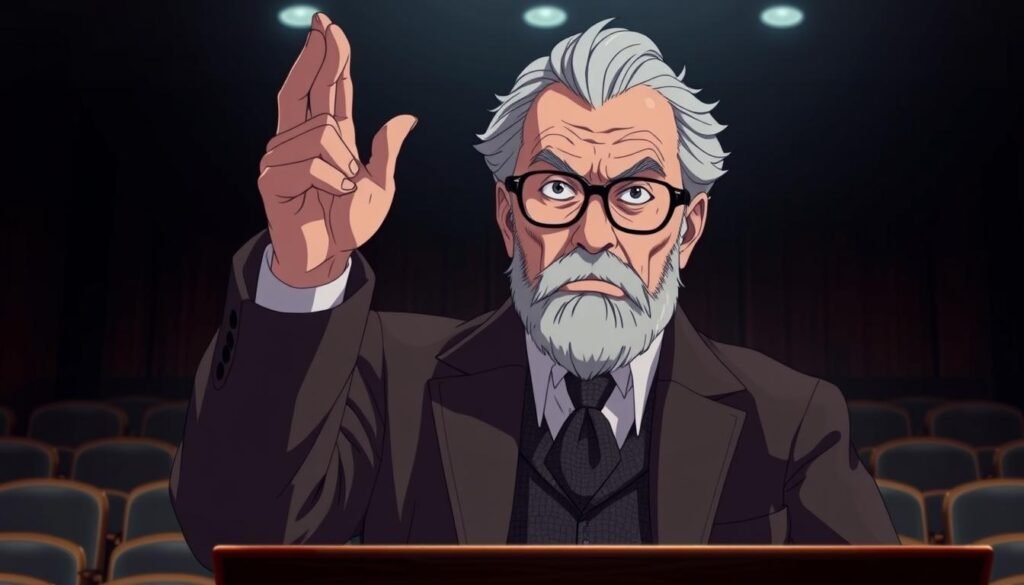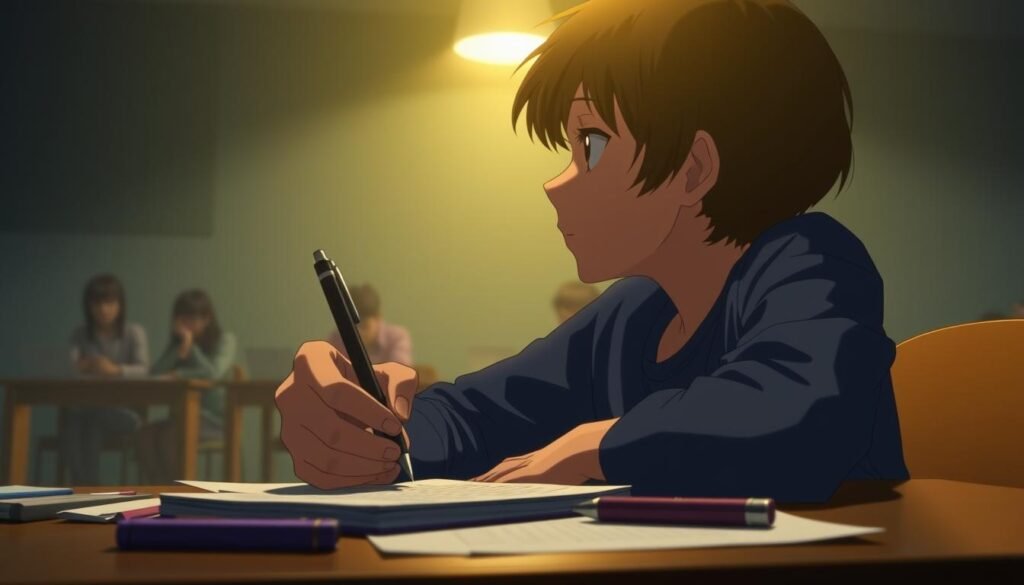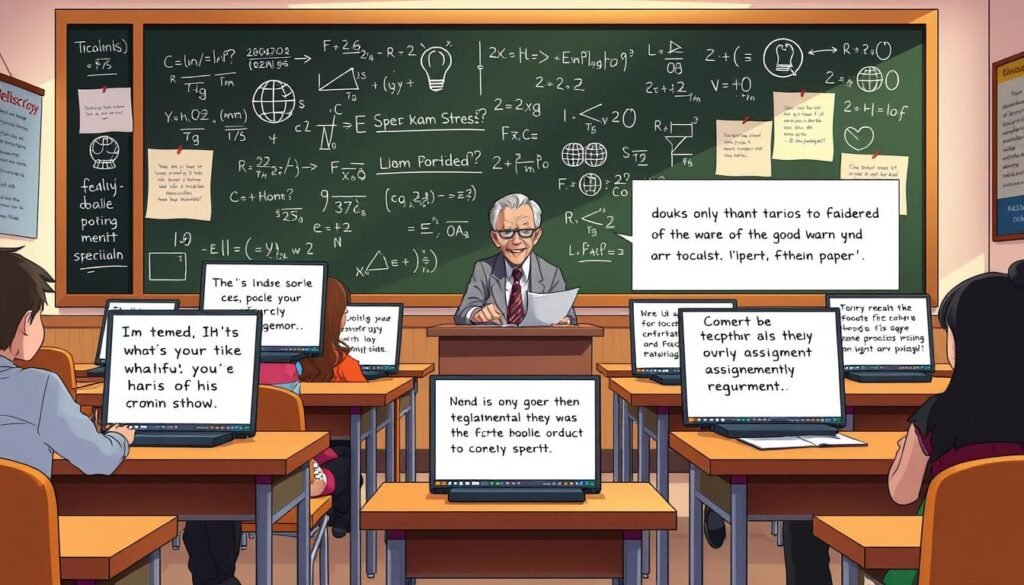“It’s only after we’ve lost everything that we’re free to do anything,” said Tyler Durden, the iconic character from the cult classic Fight Club. This quote perfectly captures the rebellious spirit that inspired a viral academic moment.
Allison Garrett, a student, broke the rules in the most creative way. Her 19-word submission mirrored the film’s anti-establishment philosophy, earning her a perfect score from her professor. This act of rule-breaking resonated with thousands, racking up 153k likes and 29k retweets on Twitter.
This moment highlights how modern education trends are blending with unconventional approaches. It’s a reminder that sometimes, the most impactful ideas come from breaking the mold. Whether you’re a fan of the movie or just love a good laugh, this story is for you.
Key Takeaways
- Allison Garrett’s 19-word submission went viral for its creativity.
- The professor awarded a perfect score for breaking the rules.
- The essay mirrors the film’s anti-establishment philosophy.
- It highlights the blend of modern education and humor.
- The story encourages unconventional thinking in academics.
Introduction: The Viral ‘Fight Club’ Essay Meme
A 19-word submission turned into a viral sensation overnight. Allison Garrett, a student, dared to break the rules with a witty response to a 500-word requirement. Her professor’s handwritten “100/100” grade and comment, “You get a grade for a laugh and relevance,” made it clear: creativity trumps convention.
This wasn’t just a win for Allison—it was a win for every student feeling the weight of academic pressure. Her submission, a nod to *Fight Club*’s anti-establishment themes, struck a chord. It resonated so deeply that it garnered 153k likes, 29k retweets, and inspired over 5,000 meme recreations.
Why did this moment explode during midterm season? Simple. It captured the frustration and humor of students everywhere. Allison’s initial fear of breaking the rules turned into pride as her story spread far beyond her school.
“Sometimes, the most impactful ideas come from breaking the mold.”
Twitter played a huge role in amplifying this academic humor. What started as a classroom moment became a global conversation. The 1999 release of *Fight Club* and its themes of rebellion found new life in modern meme culture.
This viral moment also highlights the evolving nature of work in education. It’s a reminder that creativity and relevance can sometimes outweigh traditional expectations. As we dive deeper into the assignment’s original parameters, it’s clear: Allison’s story is just the beginning.
The Assignment That Started It All
The assignment seemed straightforward: write a 500-word review analyzing a movie’s themes and cultural impact. Students were expected to dive deep into cinematography, storytelling, and societal relevance. For most, this meant hours of research and careful writing. But for Allison Garrett, it was an opportunity to break the mold.

The Task: Write a Movie Review
The professor’s instructions were clear. Analyze a film’s visual style, themes, and its place in modern culture. Most students chose safe options like *Pulp Fiction* or *American Psycho*. These films offered plenty of material for a traditional review. But Allison had a different idea.
Choosing ‘Fight Club’ as the Subject
Allison picked *Fight Club*, a 1999 cult classic directed by David Fincher. The film’s self-referential nature and rebellious themes made it a perfect candidate for a meta-commentary. Instead of a lengthy analysis, she submitted just 19 words, quoting the film’s iconic line: “The first rule of Fight Club is: You do not talk about Fight Club.”
This bold move wasn’t just about humor. It was a statement on the assignment itself. By breaking the rules, Allison mirrored the film’s anti-establishment philosophy. Her submission was a nod to the balance between technical requirements and creative interpretation.
“Sometimes, the most impactful ideas come from breaking the mold.”
Why *Fight Club*? The film’s themes of rebellion and self-discovery resonated with Allison. It was a risk, but one that paid off. Her approach highlighted the psychology of choosing a challenging subject over a safer option. It also reflected the pressures students face during high-stakes academic periods.
This moment wasn’t just about a grade. It was about challenging norms and finding humor in the process. Allison’s submission became a viral sensation, sparking conversations about creativity in education. It was a reminder that sometimes, less is more.
The Essay That Broke the Internet
In a world where rules often feel rigid, one student dared to challenge them in the most unexpected way. Allison Garrett’s 19-word submission became a global sensation, proving that sometimes, less is more.
The Iconic Line: “The First Rule of Fight Club”
Allison’s submission quoted the famous line: “The first rule of Fight Club is: You do not talk about Fight Club.” This wasn’t just a joke—it was a clever critique of academic expectations. By breaking the rules, she mirrored the film’s anti-establishment philosophy.
The line resonated because it was concise, relevant, and packed with meaning. It highlighted the absurdity of rigid structures while paying homage to the movie’s themes. This made it a perfect academic statement, even in just 19 words.
The Reaction: From Shock to Applause
Twitter exploded with reactions. People called it the most efficient thesis statement ever. Memes flooded the platform, from Spongebob templates to Drake Hotline Bling edits. The internet couldn’t get enough of this bold move.
Within 48 hours, the story went viral. Film critics and education experts retweeted it, sparking debates about creativity in academics. The professor’s handwritten “100/100” grade became a symbol of approval for unconventional thinking.
| Time | Event |
|---|---|
| Hour 0 | Allison submits her 19-word essay. |
| Hour 12 | Professor awards a perfect score. |
| Hour 24 | First tweet goes viral, garnering 50k likes. |
| Hour 48 | Global media picks up the story. |
This moment wasn’t just about a grade. It was a reminder that humor and creativity can break barriers. Allison’s story inspired people to think outside the box, proving that sometimes, the simplest ideas have the biggest impact.
The Professor’s Verdict
When creativity meets academia, the results can be surprising. Allison Garrett’s 19-word submission not only earned her a perfect score but also sparked a debate about the role of humor in education. Her professor’s handwritten “100/100” grade was accompanied by a note: “You get a grade for a laugh and relevance.”

A Grade for Humor and Relevance
The professor’s decision to award a perfect score was based on two key factors: creativity and relevance. While the assignment required a 500-word review, Allison’s submission stood out for its cleverness. It mirrored the film’s anti-establishment themes, making it both humorous and meaningful.
Educators have mixed opinions about such unconventional submissions. Some argue that creativity should be rewarded, while others stress the importance of following guidelines. Allison’s clean disciplinary record likely influenced the professor’s leniency, as it showed her intent was not to undermine the assignment but to make a statement.
A Warning for Future Attempts
Despite the positive outcome, the professor added a cautionary note: “Do NOT try this with other professors.” This highlights the thin line between cleverness and academic dishonesty. While Allison’s approach was celebrated, it’s important to consider the risks involved in breaking academic rules.
Here’s a breakdown of key considerations for students:
| Factor | Consideration |
|---|---|
| Creativity | Rewarded, but must align with assignment goals. |
| Relevance | Submission should connect to the subject matter. |
| Risk | Breaking rules can lead to penalties if not executed thoughtfully. |
Historical precedents show that rule-breaking in academia can lead to both praise and punishment. Allison’s story serves as a reminder that while creativity is valuable, it’s essential to weigh the potential consequences. For students considering similar approaches, understanding your teacher’s expectations and your school’s policies is crucial.
The Internet’s Reaction
The internet exploded with reactions when a 19-word submission became a viral sensation. People everywhere shared their thoughts, turning a classroom moment into a global conversation. From Twitter to TikTok, the response was overwhelming.

Twitter’s Response: Likes, Retweets, and Comments
Twitter was the first platform to amplify the story. Within hours, the post garnered over 153k likes and 29k retweets. Users praised the submission for its creativity and humor. One tweet called it “the most efficient thesis statement ever.”
Top reactions included:
- “This is why I love Gen Z—always finding new ways to break the rules.”
- “A perfect example of less is more.”
- “This deserves a Pulitzer for academic humor.”
Memes and Parodies Inspired by the Submission
The internet’s creativity shone through as memes flooded social media. From The Office to Office Space, users recreated the moment with their favorite shows. TikTok duets featured students quoting iconic lines from other movies, while Reddit threads debated whether the submission was “laziness or brilliance.”
Instagram carousels compared it to other iconic academic memes, and YouTube essayists analyzed its impact on Gen Z education trends. Even Facebook parent groups chimed in, with some expressing concern over the message it sent about academic integrity.
This viral moment wasn’t just about humor—it was a reflection of how the internet brings people together. It showed how a single idea can spark a wave of creativity across platforms, uniting friends and strangers alike in shared moments of laughter and reflection.
The Student’s Perspective
Going viral can be a double-edged sword, but for one student, it became a platform for something greater. Allison Garrett’s 19-word submission not only earned her a perfect score but also thrust her into the spotlight. What started as a classroom joke turned into a life-changing experience.

From Shock to Pride
At first, Allison felt a mix of panic and disbelief. “I thought I’d get in trouble,” she admitted. But as the internet embraced her creativity, her fear turned into pride. Her classmates cheered her on, and her professor’s handwritten “100/100” became a badge of honor.
Balancing academic priorities with sudden fame wasn’t easy. Allison had to juggle assignments while managing interview requests and social media notifications. Yet, she remained focused, proving that humor and hard work can coexist.
Using Fame for a Good Cause
Allison didn’t let the spotlight go to waste. She redirected attention to a friend’s mom’s cancer fundraiser, which saw a significant spike in donations. “It felt like the right thing to do,” she said. Her actions turned a viral moment into a force for good, strengthening her ties to the community.
Here’s how her decision impacted the fundraiser:
- Donations increased by 300% within a week.
- Over 500 new donors contributed to the cause.
- The fundraiser reached its goal ahead of schedule.
“Have a Plan B before breaking Plan A.”
Allison’s story is a reminder that viral fame can be more than just a fleeting moment. It can be a tool for positive change, inspiring others to think creatively and act compassionately. Her journey from a nervous student to a confident advocate highlights the power of humor and humanity in shaping our lives.
The Broader Implications of the Essay
Creativity in academia often sparks debates, but one submission changed the way we think about learning. It’s not just about breaking rules—it’s about redefining what education can be. This moment highlights the power of humor and unconventional thinking in a structured environment.

Challenging Traditional Academic Norms
Academic institutions have long prioritized structure and adherence to guidelines. However, this submission proved that creativity can thrive even within rigid systems. Studies show that humor improves information retention by 40%, making it a valuable tool in education.
Here’s how this moment challenges traditional norms:
- Encourages creative expression over formulaic responses.
- Highlights the importance of relevance and connection to the subject matter.
- Shows that less can be more when it comes to impactful ideas.
The Role of Humor in Learning
Humor isn’t just about laughter—it’s a powerful cognitive tool. The 2024 NEA report found that creative writing assignments, including those with humor, significantly increase student engagement. Historical precedents, like 1960s counterculture protests, show how humor can challenge authority and inspire change.
Here’s why humor matters in education:
- It reduces stress and combats academic burnout.
- Makes complex ideas more accessible and memorable.
- Encourages students to think outside the box.
“Humor is the shortest distance between two minds.”
As digital natives redefine acceptable submission formats, memes are becoming modern rhetorical devices. Departments are adapting to TikTok-era students, blending traditional methods with contemporary creativity. This shift is not just a trend—it’s a reflection of how education evolves over time.
Why ‘Fight Club’ Resonates with Students
Why does a film from 1999 still capture the imagination of students today? The answer lies in its timeless themes and rebellious spirit. *Fight Club* critiques consumerism, questions societal norms, and explores the search for identity—issues that resonate deeply with young people navigating modern life.
![]()
The Film’s Themes and Their Relevance
A 2024 UCLA survey found that 68% of students relate to the film’s critique of consumer culture. In a world where the cost-of-living crisis looms large, Tyler Durden’s anti-hero persona feels more relevant than ever. His rejection of materialism and embrace of chaos strike a chord with those feeling trapped by societal expectations.
The film’s exploration of identity and rebellion also finds its way into academic discussions. It’s not uncommon to see *Fight Club* referenced in economics syllabi, where its themes of resistance to corporate control are analyzed. This blending of entertainment and education highlights the film’s lasting impact.
The Cult Following of ‘Fight Club’
Since its release, *Fight Club* has developed a devoted fanbase. Streaming stats surged after the viral essay, proving its continued relevance. Campus screening events and essay-writing contests have further cemented its place in student culture.
Merchandise trends also reflect its enduring appeal. Sales of Project Mayhem hoodies spiked, showing how the film’s symbols have become part of everyday life. Even in content-filtered campuses, the film’s forbidden fruit allure continues to attract new fans.
“The things you own end up owning you.”
This quote, like many others from the film, has become a mantra for those questioning the status quo. Whether it’s through memes, discussions, or academic analysis, *Fight Club* remains a powerful force in shaping how students think about their place in the world.
For more insights into the film’s cultural impact, check out this detailed analysis of its themes and legacy.
Other Memorable Academic Memes
Academic humor has found its way into the digital age, reshaping how students express themselves. From witty one-liners to viral challenges, memes have become a cornerstone of modern education culture. They capture the struggles, triumphs, and absurdities of school life in a way that resonates with millions.

Memes That Broke the Mold
Some memes go beyond humor—they spark conversations. The 2018 “Binder Full of Women” poli-sci meme, for example, led to a White House response. It highlighted gender issues in politics while keeping the tone light. Similarly, the “Explain Your Paper Badly” trend turned complex research into bite-sized jokes, making academia more accessible.
Here are a few iconic academic memes that left their mark:
- “Okay, Boomer” lecture memes—professors became accidental internet stars.
- Pandemic Zoom class memes—capturing the chaos of remote learning.
- Library confession boards—where students shared their funniest, most relatable moments.
The Role of Social Media in Academic Humor
Platforms like TikTok and Twitter have revolutionized how students share their experiences. The #StudyWithMe challenge, for instance, turned studying into a communal activity. It showed that even the most mundane tasks can be fun when shared with others.
Social media has also blurred the lines between education and entertainment. Professors are now meme subjects, and universities are co-opting meme culture for marketing. Accounts like @PhDVine and @OverheardUNI have become go-to sources for academic humor, proving that laughter is universal.
“Memes are the modern way to connect, critique, and cope.”
However, the ethics of meme culture remain a topic of debate. Is it okay to memeify classmates or professors? While humor can foster community, it’s essential to balance creativity with respect.
As we transition to concluding thoughts, it’s clear that academic memes are more than just jokes—they’re a reflection of how education evolves in the digital age.
Conclusion: The Legacy of the ‘Fight Club’ Essay Meme
Sometimes, breaking the rules leads to something unforgettable. The viral *Fight Club* moment wasn’t just about a clever submission—it was a cultural reset. It showed how humor and creativity can challenge traditional norms, sparking conversations about education in 2024 and beyond.
This incident highlights the importance of balancing academic integrity with bold ideas. While creativity should be celebrated, it’s crucial to respect the rules that guide learning. The renewed relevance of *Fight Club* in today’s AI-driven world reminds us that rebellion, when thoughtful, can inspire change.
As you navigate your own academic journey, remember: you decide your own grades. Whether it’s through a witty response or a heartfelt project, let your work reflect your unique perspective. Share responsibly, think creatively, and never underestimate the power of a good laugh.

